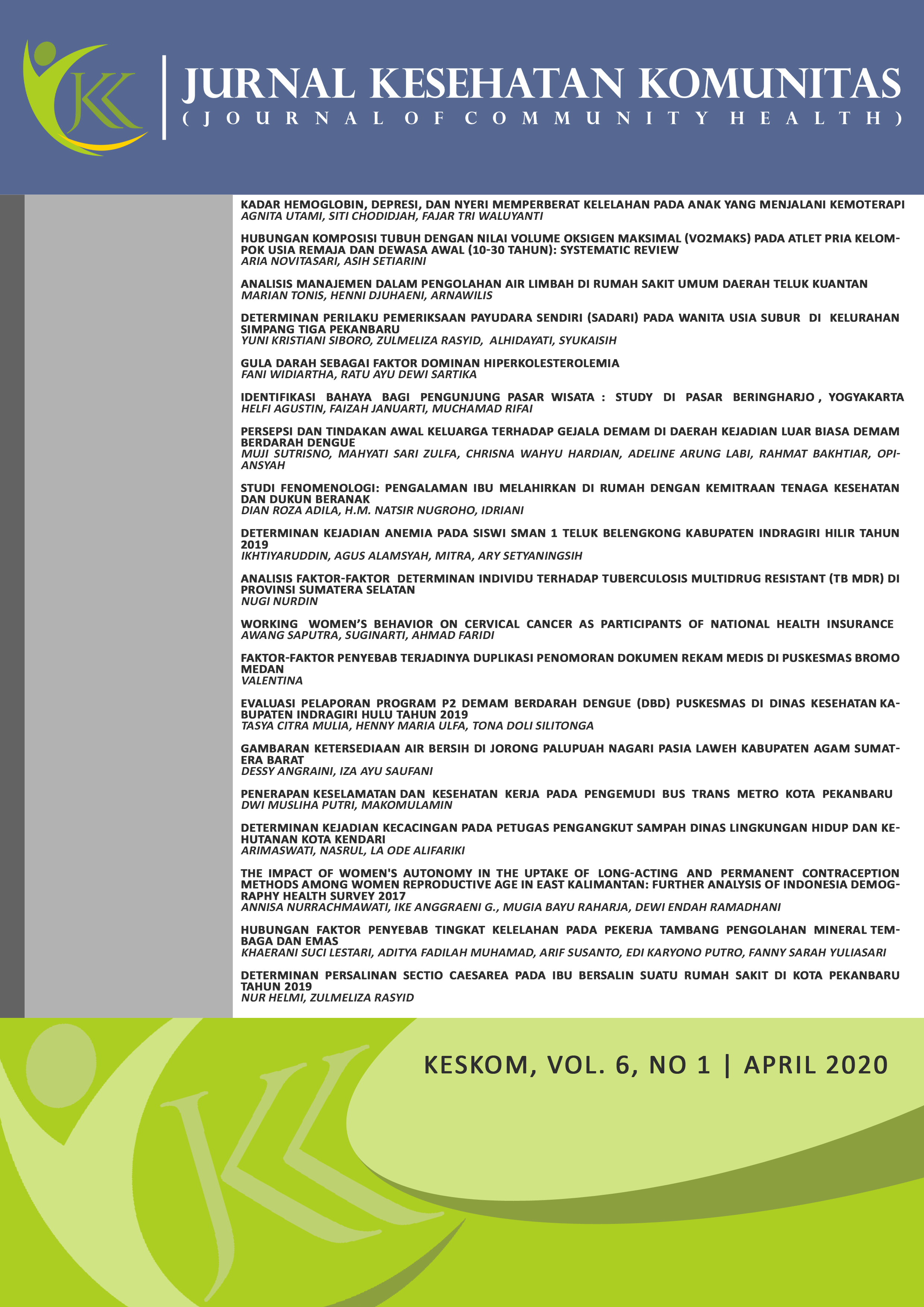The Effect of Women's Autonomy in the Uptake of Long-Acting and Permanent Contraception Methods among Women Reproductive Age in East Kalimantan
DOI:
https://doi.org/10.25311/keskom.Vol6.Iss1.511Kata Kunci:
Kata kunci: otonomi perempuan, keluarga berencana, metode jangka panjangAbstrak
Latar belakang: Meskipun tingkat fertilitas menurun, Provinsi Kalimantan Timur masih menghadapi kebutuhan KB yang tidak terpenuhi, sebagian besar penggunaan kontrasepsi masih bergantung pada metode jangka pendek. Oleh karena itu, penting untuk meneliti faktor-faktor terkait yang mempengaruhi penggunaan Metode Kontrasepsi Jangka Panjang (MKJP) dan metode permanen. Penelitian ini bertujuan untuk menganalisis pengaruh sosio demografi, pengetahuan, otonomi perempuan dan kesuburan pada penggunaan MKJP di tingkat rumah tangga.
Metode: Penelitian ini merupakan penelitian cross-sectional, data berasal dari Survei Demografi dan Kesehatan Indonesia (SDKI) 2017 Provinsi Kalimantan Timur. Sebanyak 570 wanita usia subur (10-49 tahun) dengan status perkawinan yang masih menggunakan kontrasepsi metode apa pun menjadi sampel dalam penelitian ini
Hasil: Penggunaan metode kontrasepsi jangka panjang dan permanen hanya 17% dibandingkan dengan metode jangka pendek. Faktor yang berhubungan dengan penggunaan MKJP dalam analisis bivariat adalah usia, kepemilikan asuransi, pengetahuan keluarga berencana dan otonomi perempuan (nilai p<0,05). Sementara dalam analisis multivariat hanya otonomi perempuan dan kepemilikan asuransi yang berhubungan dengan penggunaan LAPM.
Kesimpulan: Temuan ini menunjukkan perlunya memasukkan program pemberdayaan perempuan dalam program keluarga berencana.
Kata kunci: otonomi perempuan, keluarga berencana, metode jangka panjang
Unduhan
Referensi
Alabi, O., Odimegwu, C. O., De-Wet, N., & Akinyemi, J. O. (2019). Does female autonomy affect contraceptive use among women in northern Nigeria? African Journal of Reproductive Health, 23(2), 92–100. https://doi.org/10.29063/ajrh2019/v23i2.9
ALSumri, H. H. (2015). A national study: The effect of egyptian married women’s decision-making autonomy on the use of modern family planning methods. African Journal of Reproductive Health, 19(4), 68–77.
Bhandari, R., Pokhrel, K., Gabrielle, N., & Amatya, A. (2019). Long acting reversible contraception use and associated factors among married women of reproductive age in Nepal. PLOS ONE, 14, e0214590. https://doi.org/10.1371/journal.pone.0214590
Carlin, C. S., Fertig, A. R., & Dowd, B. E. (2016). Affordable care act’s mandate eliminating contraceptive cost sharing influenced choices of women with employer coverage. Health Affairs, 35(9), 1608–1615. https://doi.org/10.1377/hlthaff.2015.1457
Creanga, A. A., Gillespie, D., Karklins, S., & Tsui, A. O. (2011). Faible recours à la contraception chez les femmes africaines pauvres: Une question d’égalité. Bulletin of the World Health Organization, 89(4), 258–266. https://doi.org/10.2471/BLT.10.083329
Ilmiyah, D., Budihastuti, U., Nurhaeni, I., & Mudigdo, A. (2018). Determinants of Women’s Choice of a Long-Acting Reversible Contraceptive in Boyolali, Central Java. Journal of Maternal and Child Health, 03, 225–232. https://doi.org/10.26911/thejmch.2018.03.03.07
Judge, C. P., Wolgemuth, T. E., Hamm, M. E., & Borrero, S. (2017). “Without bodily autonomy we are not freeâ€: exploring women’s concerns about future access to contraception following the 2016 US presidential election. Contraception, 96(5), 370–377. https://doi.org/10.1016/j.contraception.2017.07.169
Kohan, S., Talebian, F., & Ehsanpour, S. (2014). Association between women’s autonomy and family planning outcome in couples residing in Isfahan. Iranian Journal of Nursing and Midwifery Research, 19, 451–455.
Mutombo, N., & Bakibinga, P. (2014). The effect of joint contraceptive decisions on the use of Injectables, Long-Acting and Permanent Methods (ILAPMs) among married female (15-49) contraceptive users in Zambia: A cross-sectional study. Reproductive Health, 11, 51. https://doi.org/10.1186/1742-4755-11-51
Potts, M. (2014). Getting family planning and population back on track. Global Health Science and Practice, 2(2), 145–151. https://doi.org/10.9745/GHSP-D-14-00012
Tibaijuka, L., Odongo, R., Welikhe, E., Mukisa, W., Kugonza, L., Busingye, I., … Bajunirwe, F. (2017). Factors influencing use of long-acting versus short-acting contraceptive methods among reproductive-age women in a resource-limited setting. BMC Women’s Health, 17. https://doi.org/10.1186/s12905-017-0382-2
Vouking, M. Z., Evina, C. D., & Tadenfok, C. N. (2014). Male involvement in family planning decision making in sub-Saharan Africa- what the evidence suggests. Pan African Medical Journal, 19, 1–5. https://doi.org/10.11604/pamj.2014.19.349.5090
Wado, Y. D., Afework, M., & Hindin, M. (2013). Unintended pregnancies and the use of maternal health services in Southwestern Ethiopia. BMC International Health and Human Rights, 13, 36. https://doi.org/10.1186/1472-698X-13-36
Zerden, M. L., Tang, J. H., Stuart, G. S., Norton, D. R., Verbiest, S. B., & Brody, S. (2015). Barriers to Receiving Long-acting Reversible Contraception in the Postpartum Period. Women’s Health Issues, 25(6), 616–621. https://doi.org/10.1016/j.whi.2015.06.004

Unduhan
Telah diserahkan
diterima
Diterbitkan
Cara Mengutip
Terbitan
Bagian
Lisensi
Hak Cipta (c) 2020 Jurnal Kesehatan Komunitas

Artikel ini berlisensiCreative Commons Attribution-NonCommercial-ShareAlike 4.0 International License.
Copyright @2017. This is an open-access article distributed under the terms of the Creative Commons Attribution-NonCommercial-ShareAlike 4.0 International License (http://creativecommons.org/licenses/by-nc-sa/4.0/) which permits unrestricted non-commercial used, distribution and reproduction in any medium










































